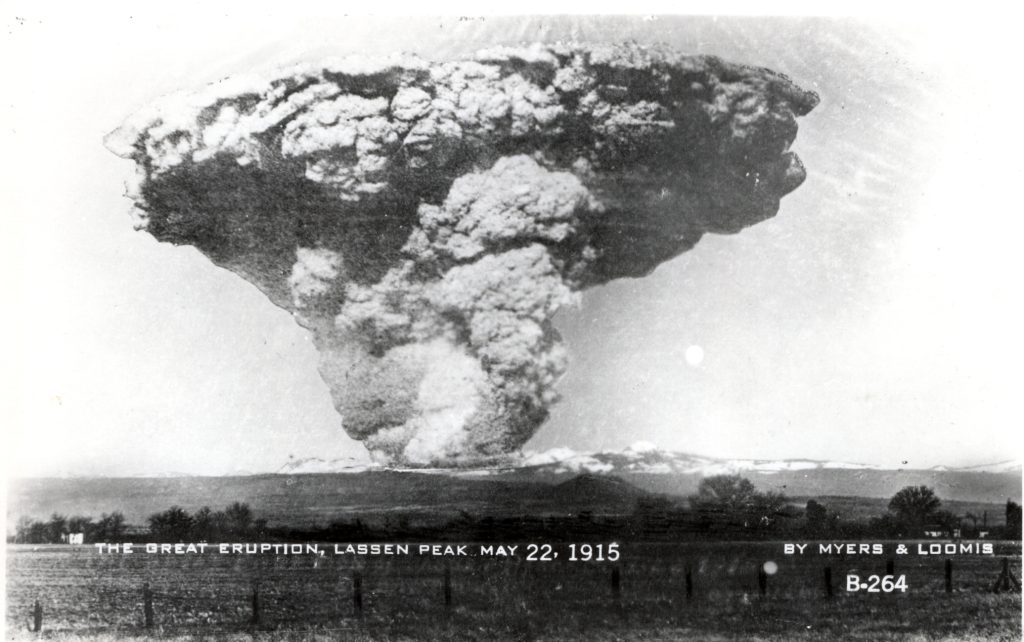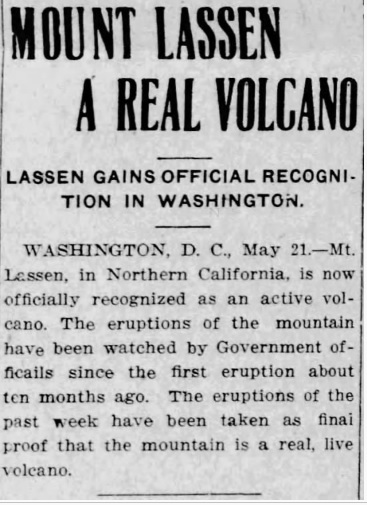Shav LaVigne
Mount Lassen
California’s Active Volcano
With all of the press coverage of the destruction and consternation caused by Hawaii’s Kilauea volcano, it is interesting and important to know that California has its own active volcano. Mount Lassen is the centerpiece of Lassen Volcanic National Park in Shasta County.

Fortunately, over the years, many photographs and postcards have been made showing this volcano and its activity within the state, but most people do not realize the potential eruption that can, and will, visit California eventually!
Mount Lassen is the southernmost active volcano in the Cascade Volcanic Arc that stretches from southwestern British Columbia, Canada to Shasta County, California. The mountain is 10,457 feet high making it the 13th highest point in California.
Although Mount Lassen is a national park of great interest and beauty, there are several better-known volcanoes to its north. These mountains include Shasta, Hood, Saint Helens, and Rainier.
In California, Mount Shasta and Mount Lassen always pose the potential to erupt at any time. The good news is that both mountains are in relatively rural areas like Mount St. Helens is in Washington state. Although there was great destruction when St. Helens erupted, there were very few victims and loss of life. Mount Hood in Oregon or Mount Rainier in Washington are closer to heavily populated areas. An eruption in either of these two places would be truly catastrophic.
Mount Lassen was named for a Danish blacksmith, Peter Lassen. It was he who guided immigrants past the Sierra peaks into the Sacramento Valley during the 1830s.
President Theodore Roosevelt established Lassen Peak National Monument in 1907. Although native populations claimed that Lassen Peak was “full of fire and water” and would erupt again, the establishment of the national monument was based on the belief that Mount Lassen was now extinct and that the area could be used to study volcanic phenomena.
On May 30, 1914, despite a lack of precursor earthquakes, Mount Lassen became volcanically active after some 27,000 years of dormancy. First came a steam explosion that carved out a small crater within a deep lake on the volcano’s summit, and then with the eruption came a change in the mountain’s status when it, and the surrounding area, became Lassen Volcanic National Park.
Over a period of eleven months in 1914, the volcano’s crater grew in diameter by more than 180 feet and reaching a length of about 1,000 feet.

On May 14, 1915, Lassen erupted sending lava blocks which extended as far as Manton, California, twenty miles west of the mountain. By the next day, the crater was filled by a large lava dome.
On May 19, 1915, a large eruption destroyed the recently formed lava dome. Although no new lava erupted, part of the destroyed dome fell on the upper flanks of the mountain that was at the time covered by thirty feet of snow. The heat of the volcanic rock hitting the snow caused an instant melting forming a lahar. A lahar is a volcanically induced mud slide consisting of water and other debris that may be present including soil, rocks, trees, and other vegetation.
The half mile wide lahar coursed down the side of the volcano traveling four miles before reaching Hat Creek. After being deflected to the northeast at Emigrant Pass, it extended another seven miles down Lost Creek. By May 20, 1915, the lower Hat Creek valley was flooded with muddy water that caused property damage but fortunately no lives were lost.
On May 22, 1915 at about 4:00 p.m. Mount Lassen produced a violent eruption that ejected rock and pumice forming a much larger and deeper crater at its summit. Within thirty minutes, volcanic ash and gas formed a column that reached altitudes of over 30,000 feet. As large of an eruption as this was, it was dwarfed by the 1980 eruption of Mount St. Helens in Washington.
After 1915, steam explosions continued for several more years. In total there were nearly four hundred eruptions between 1914 and 1921.
The information learned from Mount Lassen and Mount St. Helens during their eruptions, and afterward, has been invaluable to volcanologists.
Unlike eruptions at Mount Baker, Mount Rainier, Mount St. Helens, and Mount Hood in the 19th century, Mount Lassen and St. Helens are within easy reach of scientists with the proper and most modern tools and understanding to truly study the effects of a volcano.
While Kilauea continues to erupt in Hawaii, the volcanoes of the Cascade Volcanic Arc are very different in nature. Studying them is equally important and interesting.
* * *
[From the Editor’s Desk: The newspaper clipping below appeared in the Oroville Daily Register on Saturday morning May 22, 1915.

Even in 1915, would it occur to anyone in Washington, DC, that the citizens of Northern California already knew that Mount Lassen was a real volcano?]
It’s interesting that the “22, 1915” in the Myers & Loomis postcard’s description of the eruption is set in larger type than the words of the text.
Vey interesting, and I learned lots of new things about volcanos today!
“Dormant for 27,000 years….” Well, I’ve been dormant for about 35 years or so, maybe I too can spring to life! The cloud formation is so similar to that of nuclear explosions, I imagine it has to do with physics and the sudden release of energy.